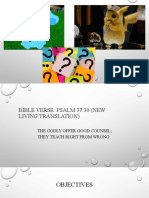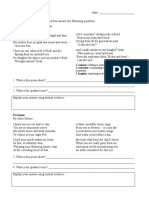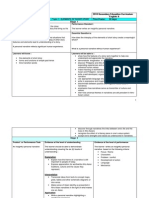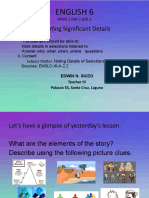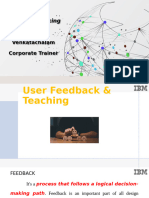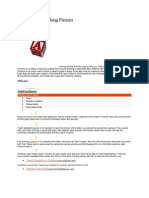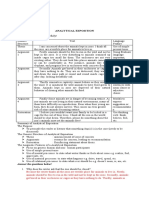Curriculum Map
Curriculum Map
Uploaded by
api-237962876Copyright:
Available Formats
Curriculum Map
Curriculum Map
Uploaded by
api-237962876Original Title
Copyright
Available Formats
Share this document
Did you find this document useful?
Is this content inappropriate?
Copyright:
Available Formats
Curriculum Map
Curriculum Map
Uploaded by
api-237962876Copyright:
Available Formats
6th Grade English/Language Arts Curriculum Map
Course Description
This course is designed to address the following Common Core State Standards English/Language Arts strands:
Language
Writing
Reading for Literature: Stories, Novels, Dramas, and Poetry
Speaking and Listening
Reading for Informational Text: Literary Nonfiction and Historical, Scientific, and
Technical Texts
Course I Can Statements
In this course, the student will be able to satisfy the following I Can statements.
Reading
I can comprehend a variety of literature independently and proficiently.
I can comprehend literature by analyzing, inferring, and drawing
conclusions about literary elements, themes, and central ideas.
I can comprehend literature by using knowledge of literary structure and
point of view.
I can read and comprehend a variety of nonfiction independently and
proficiently.
I can extract and construct meaning from nonfiction texts using a range
of comprehension skills.
I can understand nonfiction text using knowledge of structural
organization and authors purpose and message.
I can understand nonfiction texts by evaluating specific claims and
connecting ideas.
I can acquire, refine, and apply vocabulary using various strategies and
sources.
I can build my comprehension by determining or clarifying figurative,
connotative, and technical meanings.
I can write simple, compound, complex, and compound-complex
sentences.
I can demonstrate the commands of the conventions of capitalization,
punctuation, and spelling.
Writing
I can write effectively for a variety of tasks, purposes, and audiences.
I can develop and refine writing skills by writing for different purposes
and to specific audiences.
I can produce essays by planning, drafting, editing, and collaborating with
others.
I can build knowledge about the research process and the topic by
conducting research.
Language
I can use a variety of pronouns correctly.
P a g e 1 | 25
Revision Date: January 2015
6th Grade English/Language Arts Curriculum Map
Course Standard Links
Teachers may find access to additional information on the Common Core State Standards at the following websites:
http://www.doe.in.gov/achievement/curriculum/resources-implementing-indianas-common-core-standards
Other Standards
Although ELA will implement the Common Core State Standards, teachers are expected to integrate the standards for Information and
Technology Skills and English Language Development. You can find these standards at the following websites.
Teacher created, digital lessons designed around the Common Core Standards. The lessons can be used during instruction, to support
teachers understanding of the Common Core Standards, and provide online support to students. http://learnzillion.com/
Resources to implement the Common Core State Standards. The site contains current, relevant, evidence-based tools and professional
development to smooth the transition to Common Core. http://educore.ascd.org/default.aspx This website is full of free content designed to
help educators understand and implement the Common Core State Standards. It includes practical tools designed to help students and
teachers see their hard work deliver results. It was created in the spirit of collaboration. Please steal these tools and share them with others.
http://www.achievethecore.org/
TIMELINE
UNIT
35 days
August 5September
30
Introducti
on to 6th
grade
Language
Arts
MAJOR
CONCEPTS
Indiana CCR
Standards
STUDENT I CAN
STATEMENTS
ACADEMIC
VOCABULAR
Y
NOVELS, SHORT
STORIES, POETRY,
INFORMAL TEXT
1
Organization of
Writing
Reading
Nonfiction:
6.RN.2.2
Topics/Ideas for
Writing
Graphic Organizer
Types of Sentences
Genres
Fiction/Nonficti
on
Reading
Literature:
6.RL.2.2
6.RL.2.3
I can determine how a central
Genres:
idea of a text is conveyed through fiction
particular details and provide an nonfiction
objective summary of the text.
Text Features:
Bibliography
Index
Headings
I can determine how a central
Graphics
idea of a text is conveyed through
Captions
particular details.
I can explain how a plot unfolds
in a series of episodes.
Plot
Close Reading
P a g e 2 | 25
I can interpret figures of speech
Parts of a
Paragraph:
Main Ide
Supports
Conclusion
Fiction:
Romeo and JulietAdapted from the play
by William
Shakespeare
Eleven-Short Story
(SpringBoard)
Holes-Louis Sachar
Nonfiction:
The Mighty Mars
Rovers: The Incredible
Adventure of Spirit and
Opportunity-Elizabeth
Rusch
Revision Date: January 2015
6th Grade English/Language Arts Curriculum Map
Text Features
Figurative
Language
Main Idea
Reading
Vocabulary:
6.RV.3.3
Writing:
6.W.3.2
6.W.6.1
6.W.6.2
in context.
I can:
Introduce a topic, organize
ideas, and provide a conclusion
statement.
Use appropriate transitions to
clarify the relations among
ideas and concepts
I can write simple, compound,
and complex sentences.
I can demonstrate command of
the conventions of standard
English in my writing.
ESSENTIAL QUESTIONS THAT GUIDE
UNIVERSAL UNDERSTANDING
What are the differences between fiction and
nonfiction?
How do text features help readers
understand nonfiction?
What are the essential parts of a perfect
paragraph?
How can graphic organizers help writers
create a paragraph?
What are the five parts of a traditional plot?
Why is textual evidence important?
P a g e 3 | 25
Sentences:
Simple
Compound
Complex
Plot:
exposition
rising action
climax
falling
action
resolution
Holy Cow!-Laura
McClure
(www.readworks.org)
Various Tween Tribune
Articles
Various SCOPE Articles
Poetry:
Let it Go-Song from
Disneys Frozen
Personification
Simile
Metaphor
Hyperbole
Onomatopoeia
_______
Tier Two
Vocabulary
Instruction
Caesars
English Book
2
Units 1-2
STUDENT
REQUIRED
WRITING
Structure of a
Paragraph
Topic Sentence
Supporting Details
Concluding
Sentence
Summaries of texts
Teacher-modeled
Guided Practice
Student-written
GIST Format
Informational Essay
Revision Date: January 2015
6th Grade English/Language Arts Curriculum Map
How can figurative language enhance a text?
How can I use textual evidence to write a
summary?
TIMELINE
UNIT
MAJOR
CONCEPTS
Indiana CCR
Standards
STUDENT I CAN STATEMENTS
Reading
Literature:
6.RL.2.3
6.RL.3.2
6.RL.4.1
I can explain how a plot unfolds in a
series of episodes.
ACADEMIC
VOCABULA
RY
Teacher-modeled
Guided Practice
Student-written
Five Paragraphs
Supporting Details
Word Choice
Transitions
Introduction
Conclusion
Thesis Statement
NOVELS, SHORT
STORIES, POETRY,
INFORMAL TEXT
2
12 Days
October 123
Stories
of
Person
al
Change
P a g e 4 | 25
Figurative
Language
Theme
Point of View
Problem/Resolut
ion
Informational
Writing
Sentence
Fluency
I can explain how an author develops
the point of view.
I can compare and contrast the
experience of reading a story with
listening to an audio version of the
text.
Figurative
Language:
Simile
Metaphor
Onomatopo
eia
Alliteration
Imagery
Personificati
on
Fiction:
Flipped-Excerpt by
Wendelin Van Draanen
(SpringBoard)
Nonfiction:
My SuperpowersDan Greenburg
(SpringBoard)
Kira-Kira-Excerpt by
Cynthia Kadohata
Revision Date: January 2015
6th Grade English/Language Arts Curriculum Map
Reading
Nonfiction:
6.RN.4.2
6.RN.2.1
Reading
Vocabulary:
6.RV.2.1
6.RV.3.3
Writing:
6.W.3.2
6.W.6.2
6.W.3.3
6.W.6.2a
6.W.6.1a
6.W.6.1e
ESSENTIAL QUESTIONS THAT
GUIDE UNIVERSAL
UNDERSTANDING
Why is textual evidence important?
Media
Literacy:
6.ML.2.1
I can integrate information presented
in different media or formats.
I can site textual evidence to support
analysis of a text.
I can use context to determine or
clarify the meaning of words and
phrases.
I can interpret figures of speech in
context.
I can:
Introduce a topic, organize ideas,
and provide a conclusion statement.
Use appropriate transitions to clarify
the relations among ideas and
concepts
I can demonstrate command of the
conventions of standard English in my
writing.
Point of
View:
First
person
Third
person
(SpringBoard)
The Jacket-Gary
Soto
(SpringBoard)
Various Tween Tribune
Articles
Informational
Narrative
Various SCOPE Articles
Capitalization
Punctuation
Constructed
Response
Poetry:
Imperfect Me from
Hormone Jungle-Brod
Bragert
(SpringBoard)
_______
Tier Two
Vocabulary
Instruction
Caesars
English
Book 2
Units 3-4
STUDENT
REQUIRED
WRITING
I can use a variety of pronouns in the
appropriate writing setting.
I can use evidence to evaluate the
accuracy of information.
How can figurative language enhance a
text?
Constructed responses
to nonfiction articles
using textual
evidence.
What are the necessary tools in the
construction of an Informational piece of
writing?
How can recognizing point of view
P a g e 5 | 25
Teacher-modeled
Guided Practice
Student-written
Paragraph/Yes,
MAAM form
Used sentence
starters that show
Revision Date: January 2015
6th Grade English/Language Arts Curriculum Map
enable the reader to better understand
the text?
evidence was pulled
from text.
Personal Narrative
How can I use textual evidence to write
a summary?
TIMELINE
UNIT
23 Days
October 26
November
25
Stories
of
Change
MAJOR
CONCEPTS
Indiana CCR
Standards
STUDENT I CAN STATEMENTS
Reading
Literature:
6.RL.2.3
6.RL.3.2
6.RL.4.1
I can explain how a plot unfolds in a
series of episodes.
ACADEMIC
VOCABULA
RY
Develop events and
characters through
dialogue, pacing,
and descriptive
details.
Sequence events
Transitions
Word Choice
Pronoun Use,
Sentence Variety,
Dialogue
NOVELS, SHORT
STORIES, POETRY,
INFORMAL TEXT
P a g e 6 | 25
Plot
Theme
Point of View
Setting
Problem/Resolut
ion
I can explain how an author develops
the point of view.
Parts of a
Story:
Theme
Setting
Plot
Fiction:
The Cay- Theodore
Taylor
Hatchet-Gary Paulsen
"Thank you M'am"Langston Hughes
Revision Date: January 2015
6th Grade English/Language Arts Curriculum Map
Sentence
Fluency
I can compare and contrast the
experience of reading a story with
listening to an audio version of the
text.
Reading
Nonfiction:
6.RN.4.2
6.RN.2.1
I can integrate information presented
in different media or formats.
I can site textual evidence to support
analysis of a text.
(SpringBoard)
Point of
View:
First
person
Third
person
Narrative
Capitalization
Reading
Vocabulary:
6.RV.2.1
6.RV.3.3
I can use context to determine or
clarify the meaning of words and
phrases.
I can interpret figures of speech in
context.
Punctuation
Constructed
Response
Short Story
Writing:
6.W.3.2
6.W.6.2
6.W.3.3
6.W.6.2a
6.W.6.1a
6.W.6.1e
Media
Literacy:
6.ML.2.1
I can:
Introduce a topic, organize ideas,
and provide a conclusion statement.
Use appropriate transitions to clarify
the relations among ideas and
concepts
I can demonstrate command of the
conventions of standard English in my
writing.
I can use a variety of pronouns in the
appropriate writing setting.
I can use evidence to evaluate the
accuracy of information.
P a g e 7 | 25
_______
Tier Two
Vocabulary
Instruction
Caesars
English
Book 2
Units 5-6
Pandora and the
Whispering Box from
Enid Blytons Tales of
Ancient Greece
(SpringBoard)
The Treasure of
Lemon Brown-Walter
Dean Myer
(SpringBoard)
The Mysteries of
Harris Bcrurdick-Chris
Van Allburg
(SpringBoard)
Nonfiction:
Call of the Deep
Wilds Reading Street
Bear Attack: The
Story of Seven Boys
and One Grizzly
Article in Readers
Digest
http://www.rd.com/tru
e-stories/survival/bearattack-the-story-ofseven-boys-and-onegrizzly
About Gary
Biographyhttp://www.randomhou
se.com/features/garyp
aulsen/about.html
Revision Date: January 2015
6th Grade English/Language Arts Curriculum Map
Various Tween Tribune
Articles
Various SCOPE Articles
Poetry:
Survival on the Cayhttp://www.writersbub
ble.com/survival-onthe-cay-poem-basedon-the-cay-book/
ESSENTIAL QUESTIONS THAT
GUIDE UNIVERSAL
UNDERSTANDING
What are the five parts of a traditional
plot?
What is learned during the different
parts of plot?
Why is textual evidence important?
How can recognizing point of view
enable the reader to better understand
the text?
How can I use textual evidence to write
a summary?
STUDENT
REQUIRED
WRITING
Constructed responses
to nonfiction articles
using textual
evidence.
Short Story
P a g e 8 | 25
Teacher-modeled
Guided Practice
Student-written
Paragraph/Yes,
MAAM form
Used sentence
starters that show
evidence was pulled
from text.
Conflict
Characters
Setting
Point of View
Sequence
Exposition and
resolution
Transitions
Word Choice
Pronoun Use
Revision Date: January 2015
6th Grade English/Language Arts Curriculum Map
TIMELINE
UNIT
MAJOR
CONCEPTS
Indiana CCR
Standards
STUDENT I CAN STATEMENTS
ACADEMIC
VOCABULARY
NOVELS, SHORT
STORIES,
POETRY,
INFORMAL TEXT
Reading
Literature:
6.RL.2.2
6.RL.4.2
I can determine how a theme or
central idea of a work of literature is
conveyed through particular details.
Theme
I can provide an objective summary of
the text.
Inference
Fiction:
"The Little
Mermaid-Excerpt
by Hans Christian
Anderson
(SpringBoard)
4
November
30December
17
The
Power
of
Change
Theme
Setting
Summary
Textual
Evidence
I can compare and contrast works of
literature in different forms or genres
in their approach to similar themes
and topics.
Informative
Writing
Argumentative
Writing
Reading
Nonfiction:
6.RN.2.1
Reading
Vocabulary:
6.RV.2.5
6.RV. 3.2
I can cite textual evidence from a
nonfiction text.
I can consult reference materials, both
print and digital, to find the
pronunciation of a word or determine
its meaning.
I can write informative compositions
that introduce a topic, organize ideas,
and provide a concluding section.
I can edit and revise my work.
P a g e 9 | 25
Credible
Sources
Love that DogSharon Creech
Persuasive
Techniques
Informative
Editing
Revising
I can determine the meaning of words
and phrases as they are used in
nonfiction text.
Writing:
6.W.3.2
6.W.4
Cite
_______
Tier Two
Vocabulary
Instruction
Caesars
English Book 2
Units 7-8
Hate that CatSharon Creech
Nonfiction:
My Life in Dog
Years-Gary Paulsen
He Might Have
Liked Me Better
with My Tail-Ima
Mermaid
(SpringBoard)
Travels with
Charley-Excerpt by
John Steinbeck
(SpringBoard)
Saying Farewell to
a Faithful Pal-John
Grogan
(SpringBoard)
Revision Date: January 2015
6th Grade English/Language Arts Curriculum Map
Dogs Make Us
Human
From Animals In
Translation-Temple
Grandin and
Catherine Johnson
(SpringBoard)
My Story From
Animals In
Translation-Temple
Grandin and
Catherine Johnson
(SpringBoard)
Various Tween
Tribune Articles
Various SCOPE
Articles
Poetry:
And Although
the Little Mermaid
Sacrificed
Everything to Win
the Love of the
Prince, the Prince
(Alas) Decided to
Wed AnotherJudith Viorst
(SpringBoard)
P a g e 10 | 25
Revision Date: January 2015
6th Grade English/Language Arts Curriculum Map
Film Clip:
Temple Grandin
(SpringBoard)
ESSENTIAL QUESTIONS THAT
GUIDE UNIVERSAL
UNDERSTANDING
STUDENT
REQUIRED
WRITING
What are the necessary tools in the
construction of an Informational piece of
writing?
Constructed
responses to texts
using textual
evidence.
Teacher-modeled
Guided Practice
Student-written
Paragraph/Yes,
MAAM form
Used sentence
starters that show
evidence was
pulled from text.
How does using textual evidence
enhance a response to a piece of
nonfiction?
Informational Essay
Engaging hook
Clear thesis
Insightful
conclusion
Variety of
transitions
Topic sentences
Integrate
evidence from
various sources
Parallel structure
P a g e 11 | 25
Revision Date: January 2015
6th Grade English/Language Arts Curriculum Map
TIMELINE
UNIT
MAJOR
CONCEPTS
Indiana CCR
Standards
STUDENT I CAN
STATEMENTS
ACADEMIC
VOCABULARY
NOVELS, SHORT
STORIES,
POETRY,
INFORMAL TEXT
Argumentative
Claim
Counterargument
Bias
Persuasive
Techniques
Tone
Nonfiction:
Dont Ban Peanuts
at School, but Teach
About the Dangers
Register Editorial
Board
(SpringBoard)
Writing Process
Editing
Revising
Penny Problem: Not
Worth Metal Its Made
Of-Yunji de Nies
(SpringBoard)
5
28 Days
January 4January 29
Changing
Perspectiv
es
Textual Evidence
Argumentative
Writing
Reading
Nonfiction
6.RN.2.1
6.RN.4.1
I can trace and evaluate the
argument and specific claims in
a text.
Research
Reading
Literature
6.RL.3.2
Reading
Vocabulary:
P a g e 12 | 25
I can cite textual evidence to
support analysis of what a text
says.
I can explain how the speaker
impacts the mood, tone, and
meaning of a text.
Research
Should Dodge Ball
Be Banned in
Revision Date: January 2015
6th Grade English/Language Arts Curriculum Map
6.RV.2.3
6.RV.3.2
Writing:
6.W.3.2
6.W.4
6.W.5
I can distinguish among the
connotations of words with
similar denotations.
Cite
Credible Sources
Vocabulary
Building
I can determine the meaning of
words and phrases as they are
Connotation
used in nonfiction text, including Denotation
figurative, connotative, and
technical meanings.
_______
I can write an argument that
introduces a claim, supports the
claim with clear reasons, uses
appropriate transitions,
establishes a specific style and
tone, and provides a concluding
section.
I can apply the writing process
to plan and develop; draft;
revise and edit to strengthen
writing that is clear.
I can conduct short research
assignments and tasks to build
knowledge about the research
process.
Tier Two
Vocabulary
Instruction
Caesars
English Book 2
Units 10-12
Schools?-Time for
Kids
(SpringBoard)
Most Dangerous
Sport of All May Be
Cheerleading-Lisa
Ling and Arash
Ghadishah
(SpringBoard)
High School Football:
Would a Pop Warner
Ban Limit
Concussions?-Tina
Akouris
(SpringBoard)
Letter on Thomas
Jefferson-John
Adams
(SpringBoard)
The Pros and Cons of
Social Networking for
Teenagers: A Parents
Guide-Kristin
Stanberry
(SpringBoard)
Social Networkings
Good and Bad
Impacts on KidsScience Daily
(SpringBoard)
P a g e 13 | 25
Revision Date: January 2015
6th Grade English/Language Arts Curriculum Map
Pro & Con
Arguments: Are social
networking sites good
for our society?
(SpringBoard)
ESSENTIAL QUESTIONS THAT GUIDE
UNIVERSAL UNDERSTANDING
How is an argumentative piece of writing
different from a persuasive writing? What
are some of the key features in each that
demonstrate the differences?
What is the significance behind critically
analyzing a source's information? Why must
I use a credible source when supporting
claims in an argumentative piece?
How does using textual evidence enhance a
response to a piece of nonfiction?
How does the correct use if transitions
enhance the flow of my writing?
P a g e 14 | 25
STUDENT
REQUIRED
WRITING
Responses to texts
using textual
evidence
Paragraph/Yes,
MAAM format
Use sentence
starters that show
evidence was
pulled from text.
Argumentative Essay
Clear Claim
Counterclaims
Evidence
Facts, Details,
Quotes
Transitions
Word choice
Revision Date: January 2015
6th Grade English/Language Arts Curriculum Map
TIMELINE
UNIT
MAJOR
CONCEPTS
Indiana CCR
Standards
STUDENT I CAN
STATEMENTS
ACADEMIC
VOCABULAR
Y
NOVELS, SHORT
STORIES, POETRY,
INFORMAL TEXT
6
20 Days
February 1stFebruary 26
The
Freedo
m that
Comes
with
Change
Textual
Evidence
Review of
Genres of
Writing
Compare and
Contrast
Reading
Nonfiction:
6.RN.3.3
6.RN.4.1
I can determine an authors
perspective or purpose in a text, and
explain how it is conveyed in the
text.
Narrative
Argumentative
I can trace and evaluate the
argument and specific claims in a
text.
Reading
Literature:
6.RL.2.1
6.RL.4.2
Writing
6.W.3.1
6.W.3.2
6.W.3.3
Textual
Evidence
I can cite textual evidence to
Context Clues
support analysis of what a text says
as well as inferences drawn from the Genre
text.
Informational
Narrative
I can determine the meaning of
Argumentat
words and phrases as they are used
ive
in a nonfiction text.
Reading
Vocabulary:
6.RV.3.2
I can write a compare and contrast
essay that:
Introduces a topic
Organizes ideas
Develops the topic with relevant
facts
Provides a concluding statement
Includes transitions
I can:
Write an argument that introduces a
claim, supports the claim with
clear reasons, and provides a
concluding statement.
P a g e 15 | 25
Informational
_______
Tier Two
Vocabulary
Instruction
Caesars
English Book
2
Units 13-14
Fiction:
Boys Life-Excerpt by
Robert McCammon
Emancipation: A Life
Fable-Kathryn Hulik
A New Start-Letter
PARCC Practice Book
The Fun They HadIsaac Asimov- Writing
Workshops (SpringBoard)
Dog Breath- Dav Pilkey
Nonfiction
A New Arrival
PARCC Practice Book
"The Benefits of Pets
Writing Workshops
(SpringBoard)
Fun and Feisty-Writing
Workshops
(SpringBoard)
Various Tween Tribune
Articles
Various SCOPE Articles
Revision Date: January 2015
6th Grade English/Language Arts Curriculum Map
ESSENTIAL QUESTIONS THAT
GUIDE UNIVERSAL
UNDERSTANDING
What are the components of a
narrative essay?
How is the use of dialogue important
in a narrative?
What are the components of an
Informational essay?
What are the components of an
argumentative essay?
How does using context clues and
other active reading strategies help
oneself have a better understanding of
the vocabulary?
How do literary elements help to
convey the author's purpose?
How does recognizing the author's
purpose give the reader a better
understanding of the text?
I can write an Informational
composition that:
Introduce a topic, organize ideas,
and provide a conclusion
statement.
Use appropriate transitions to
clarify the relations among ideas
and concepts
STUDENT REQUIRED
WRITING
Responses to texts using
textual evidence
I can write a narrative that:
Engage the reader by developing
an exposition
Organize an event sequence
Use dialogue, pacing, and
descriptions to develop events
Provide an ending that follows
from the narrated experience.
Paragraph/Yes, MAAM
format
Use sentence starters
that show evidence was
pulled from text.
Argumentative Essay
Clear Claim
Counterclaims
Evidence
Facts, Details, Quotes
Transitions
Word choice
Informational Essay
Engaging hook
Clear thesis
Insightful conclusion
Variety of transitions
Topic sentences
Integrate evidence from
various sources
Narrative
P a g e 16 | 25
Conflict
Characters
Setting
Point of View
Sequence
Exposition and
Revision Date: January 2015
6th Grade English/Language Arts Curriculum Map
TIMELINE
UNIT
MAJOR
CONCEP
TS
Indiana CCR
Standards
STUDENT I CAN
STATEMENTS
ACADEMIC
VOCABULA
RY
resolution
Transitions
Word Choice
Pronoun Use
NOVELS, SHORT
STORIES, POETRY,
INFORMAL TEXT
7
February 29March 24
26 Days
Changes in
the World
Conventio
ns
Context
Clues
Reading
Literature:
6.RL.2.2
6.RL.3.1
Central
Idea of
Text
Authors
Perspectiv
e/
Authors
Point of
View
Reading
Nonfiction:
6.RN.3.3
Conflict
Reading
Vocabulary:
6.RV.3.1
Debate
Writing:
6.W.1
6.W.6.1
6.W.6.2
P a g e 17 | 25
I can determine how a theme or
central idea of a work of
literature is conveyed through
particular details.
I can analyze how a particular
sentence, chapter, scene, or
stanza fits into the overall
structure of a work of literature.
I can determine an authors
perspective or purpose in a text,
and explain how it is conveyed.
Theme
Authors
Perspective/
Authors Point
of View
First Person
Third Person
Limited
Third Person
Omniscient
Third Person
Objective
Conflict
External
Man Vs.
I can determine the meaning of
Society
words and phrases as they are
used in works of literature.
_______
I can write routinely over a
variety of time frames for a
range of tasks, purposes, and
audiences.
Tier Two
Vocabulary
Instruction
Caesars
Fiction:
Among the HiddenMargaret Haddix
Nonfiction:
Skyscraper FarmsKathryn Hulick
(Indiana DOE)
China Today-Chinas
Population
http://www.readworks.or
g/passages/china-todaychinas-population
Vertical FarmingRavindra Krishnamurthy
http://permaculturenews.
org/2014/07/25/verticalfarming-singaporessolution-feed-localurban-population/
Various Tween Tribune
Articles
Various SCOPE Articles
Revision Date: January 2015
6th Grade English/Language Arts Curriculum Map
I can demonstrate command of
English grammar and usage.
I can demonstrate command of
the conventions of standard
English in my writing.
Discussion and
Collaboration:
6.SL.2.1
ESSENTIAL QUESTIONS THAT
GUIDE UNIVERSAL
UNDERSTANDING
How can recognizing and understanding
theme enable the reader to better
understand the text?
Why is it important to analyze particular
chapters, scenes, or stanzas within a work
of literature?
Why is it important to understand the
authors purpose for writing a particular
text?
How can bad conventions negatively affect
an otherwise well-told piece of writing?
Why is it important to use correct grammar
and conventions in writing?
P a g e 18 | 25
English Book
2
Units 15-16
Poem:
Another Mountain
(Reading Street)
I can engage in collaborative
discussions building on others
ideas and expressing personal
ideas clearly
STUDENT REQUIRED
WRITING
Journals for literature
responses
Responses to texts using
textual evidence
Paragraph/Yes, MAAM
format
Use sentence starters
that show evidence
was pulled from text.
Debate
Engage in discussion
Build on others ideas
Express personal
ideas clearly
Use evidence to
support
Revision Date: January 2015
6th Grade English/Language Arts Curriculum Map
P a g e 19 | 25
Revision Date: January 2015
6th Grade English/Language Arts Curriculum Map
TIMELI
NE
UNIT
MAJOR
CONCEPTS
Indiana CCR
Standards
STUDENT I CAN STATEMENTS
ACADEMIC
VOCABULARY
NOVELS, SHORT
STORIES,
POETRY,
INFORMAL TEXT
Argumentative
Bias
Credible
Sources
Thesis
Statement
Hook
Claim
Counterargume
nt
Citing Textual
Evidence
Fiction:
Space Cadets-A
Drama by David
LaBounty
(Reading Street)
8
April 4April 29
20 Days
Changes
in Space
Explorati
on
Summary
Textual Evidence
Reading
Literature:
6.RL.2.1
6.RL.2.2
I can cite textual evidence.
I can provide an objective summary of
the text.
Argumentative
Writing
Reading
Nonfiction:
6.RN.4.1
Reading
Vocabulary:
6.RV.2.5
Writing:
6.W.3.1
6.W.4
I can trace and evaluate the argument
and specific claims in a text.
I can consult reference materials, both
print and digital, to find the
pronunciation of a word or determine its
meaning.
I can:
Write an argument that introduces a
claim, supports the claim with clear
reasons, and provides a concluding
statement.
Use credible sources when
supporting claims.
I can edit and revise my work.
P a g e 20 | 25
Writing
Techniques
Editing
Revising
Primary and
Secondary
Sources
_______
Tier Two
Vocabulary
Instruction
Caesars
English Book 2
Nonfiction:
Human Travel to the
Moon and Mars:
Waste of Money or
Next Frontier? USA
Todays Debate:
Voice and
Perspectives
The Mighty Mars
Rovers: The
Incredible
Adventure of Spirit
and OpportunityElizabeth Rusch
The Domes of Mars
Casper Brundle
(Leveled Reader
Read Aloud)
Markie the
Moonman
(Leveled Reader
Read Aloud)
Revision Date: January 2015
6th Grade English/Language Arts Curriculum Map
Media
Literacy:
6.ML.1
6.ML.2.2
Units 17-18
I can critically analyze information
found in electronic, print, and mass
media.
I can identify the target audience of a
message.
The Solar System
and
Beyond-Jen Coates
Conroy- teacher
selected
excerpts
(Leveled Reader)
The United States
and
Russian Space
RaceKathleen Cox
teacher selected
excerpts
(Leveled Reader)
Destination: MARSScott Gillam
teacher selected
excerpts
(Leveled Reader)
"Exploring Space
Travel
(Reading Street)
Summary of the
Pros and Cons of
Human Space
Exploration
http://thefutureofspac
exploration.wordpress.
com/2012/06/06/sum
mary-of-the-pros-andcons-of-human-spaceexploration-26-2/
P a g e 21 | 25
Revision Date: January 2015
6th Grade English/Language Arts Curriculum Map
Pros and Cons of
Space Exploration
http://apecsec.org/p
ros-and-cons-ofspace-exploration/
Various Tween
Tribune Articles
Various SCOPE
Articles
Poetry:
Song of the Stars
http://www.windows
2universe.org/art_a
nd_music/songstars.
html
Film Clips:
http://www.cbsnews
.com/news/neilarmstrongs-2005interview-first-man/
Pros and Cons of
Space Exploration
http://apecsec.org/p
ros-and-cons-ofspace-exploration/
ESSENTIAL QUESTIONS THAT
GUIDE UNIVERSAL
UNDERSTANDING
How is an argumentative piece of
writing different from a persuasive
writing? What are some of the key
features in each that demonstrate the
differences?
P a g e 22 | 25
STUDENT
REQUIRED
WRITING
Argumentative
Essay
Clear Claim
Counterclaims
Evidence
Revision Date: January 2015
6th Grade English/Language Arts Curriculum Map
What is the significance behind critically
analyzing a source's information? Why
must I use a credible source when
supporting claims in an argumentative
piece?
Facts, Details,
Quotes
Transitions
Word choice
Responses to texts
using textual
evidence
Paragraph/Yes,
MAAM format
Use sentence
starters that
show evidence
was pulled from
text.
How can I use textual evidence to write
a summary?
How can I determine the theme in a
work of literature through particular
details?
Summary
GIST Writing
Format
TIMELI
NE
UNIT
MAJOR
CONCEPTS
Indiana CCR
Standards
STUDENT I CAN
STATEMENTS
ACADEMIC
VOCABULARY
NOVELS, SHORT
STORIES, POETRY,
INFORMAL TEXT
9
May 2May 20
15 Days
Changes in
People
Research
Bibliography
Reading
Nonfiction:
6.RN.3.2
I can analyze how a particular
sentence, paragraph or chapter,
or section fits into the overall
structure of a text.
Evaluating
Sources
Plagiarism
Note-Taking
Skills
P a g e 23 | 25
Reading
Fiction:
6.RL.2.2
I can write an objective
summary of a text.
Research
Bibliography
Plagiarism
Paraphrasing
Parenthetical
Reference
Evaluate
Credible
Sources
Note Cards
Fiction:
Zoo
(Reading Street)
Nonfiction:
My Life With ChimpanzeesBiography
Jane Goodalls Career
(Reading Street)
Revision Date: January 2015
6th Grade English/Language Arts Curriculum Map
Reading
Vocabulary:
6.RV.2.1
Writing:
6.W.5
ESSENTIAL QUESTIONS THAT
GUIDE UNIVERSAL
UNDERSTANDING
How does using textual evidence
improve a response to literature?
Why is it important to have credible
sources when researching?
How does using context clues help the
reader better understand the text?
I can use context clues to
determine the meaning of words
and phrases.
I can conduct a short
research assignment that:
Formulates a research question
Gathers relevant information
from multiple sources
Assesses the credibility of each
source
Quotes or paraphrases the
information and conclusions of
others
Avoids plagiarism and provides
basic bibliographic information
Presents information
Zoos Then and Now
(Reading Street)
_______
Tier Two
Vocabulary
Instruction
Caesars
English Book
2
Units 19-20
The Chimpanzees I Love
(Reading Street)
Going Ape over
Language
(Reading Street)
Poem:
Helen Keller- Poem
http://www.poemhunter.co
m/poem/helen-keller/
STUDENT REQUIRED
WRITING
Responses to texts using
textual evidence
Paragraph/Yes, MAAM
format
Use sentence starters
that show evidence was
pulled from text.
Informational Paragraph
P a g e 24 | 25
Revision Date: January 2015
6th Grade English/Language Arts Curriculum Map
Why is it necessary to provide a
bibliography?
P a g e 25 | 25
Summary of the
research
Integrate evidence
from a variety of
sources
Revision Date: January 2015
You might also like
- Inference VS Conclusion WorksheetsDocument10 pagesInference VS Conclusion WorksheetsnuradhiatulseriNo ratings yet
- CHECKED Lesson Plan On The Wise Old Woman and Misplaced ModifiersDocument12 pagesCHECKED Lesson Plan On The Wise Old Woman and Misplaced ModifiersLancy Abegail Gabrillo CastronuevoNo ratings yet
- Context Clues Worksheet 1 3Document2 pagesContext Clues Worksheet 1 3Aye AnnteenNo ratings yet
- MLBP Worksheet Heres What We ThinkDocument3 pagesMLBP Worksheet Heres What We Thinkapi-364345627No ratings yet
- Common Core - ELA - UnpackedDocument28 pagesCommon Core - ELA - UnpackedmrkballNo ratings yet
- Adverbs of IntensityDocument1 pageAdverbs of IntensityGlenn Batacan PosugacNo ratings yet
- LMP - ENGLISH VI - 2nd Q - WK1-WK10Document20 pagesLMP - ENGLISH VI - 2nd Q - WK1-WK10JERALD HERNANDEZNo ratings yet
- Detailed Lesson (Writing)Document5 pagesDetailed Lesson (Writing)ariguindettyNo ratings yet
- Lessonplanmsc 4Document12 pagesLessonplanmsc 4Aira PeloniaNo ratings yet
- Elements of PoetryDocument6 pagesElements of PoetryLiela MoralesNo ratings yet
- CreativeWriting - SelfMade Module 3 Fiction WritingDocument14 pagesCreativeWriting - SelfMade Module 3 Fiction WritingAifel Joy Dayao FranciscoNo ratings yet
- DLL - English 6 - Q2 - W7Document5 pagesDLL - English 6 - Q2 - W7Alexa Jhel ArabisNo ratings yet
- Context Clues Lesson 3Document18 pagesContext Clues Lesson 3RamilNo ratings yet
- Sample Detailed Lesson Plan in English For Teaching DemonstrationDocument6 pagesSample Detailed Lesson Plan in English For Teaching DemonstrationMaiAce Sean Shawn SynneNo ratings yet
- Engl3403 Alternate Endings RubricDocument2 pagesEngl3403 Alternate Endings Rubricapi-260642714No ratings yet
- DLL - English 6 - Q2 - W2Document5 pagesDLL - English 6 - Q2 - W2Melanie DucalangNo ratings yet
- Engl241 Module 1 Creative Writing PDFDocument12 pagesEngl241 Module 1 Creative Writing PDFjuanNo ratings yet
- Curriculum Map For English 9 HonorsDocument3 pagesCurriculum Map For English 9 HonorsmrsfoxNo ratings yet
- English 9 PPT Day 2Document49 pagesEnglish 9 PPT Day 2Evelyn Apostol100% (1)
- Informative Writing RubricDocument2 pagesInformative Writing Rubricapi-533624966No ratings yet
- Summative Test - Q1 2Document4 pagesSummative Test - Q1 2Roxanne ManalotoNo ratings yet
- English Bingo Mechanics and RulesDocument7 pagesEnglish Bingo Mechanics and RulesLynsy Dagohoy AnastacioNo ratings yet
- Tone Worksheet 4: From Songs of An Empty HouseDocument2 pagesTone Worksheet 4: From Songs of An Empty HouseRoseNo ratings yet
- Eng Narrative Q1 Topic 1Document17 pagesEng Narrative Q1 Topic 1Dennis Niño AnchetaNo ratings yet
- 1ST QTR Lesson Plan For CotDocument2 pages1ST QTR Lesson Plan For CotLOVILLADNo ratings yet
- Chamber Theater Performance RubricDocument2 pagesChamber Theater Performance RubricLoriely Joy DuedaNo ratings yet
- English Syllabus 3Document7 pagesEnglish Syllabus 3Celina Katherine Talampas MarquezNo ratings yet
- RTP - English9-Q3-Week-3-FINAL PDFDocument11 pagesRTP - English9-Q3-Week-3-FINAL PDFRyxen Clarize100% (1)
- Rubaiyat of Omar KhayamDocument31 pagesRubaiyat of Omar KhayamAnnalie Anuta BalbiranNo ratings yet
- English 6 Pptweek 1 Day 2 QTR 3Document17 pagesEnglish 6 Pptweek 1 Day 2 QTR 3Lorna Caronan CaylaluadNo ratings yet
- PunsDocument7 pagesPunsapi-270020534No ratings yet
- Writing RubricDocument1 pageWriting Rubricapi-395353190No ratings yet
- Rhyme Rhythm Lesson PlanDocument11 pagesRhyme Rhythm Lesson Planapi-575306719No ratings yet
- Kalayaan Christian School: United Church of Christ in The PhilippinesDocument4 pagesKalayaan Christian School: United Church of Christ in The PhilippinesHil Mendoza Salvia CatainaNo ratings yet
- S4.1 - Scaffolds For Transfer SampleDocument2 pagesS4.1 - Scaffolds For Transfer SampleBenson CornejaNo ratings yet
- Final - EnglishDocument5 pagesFinal - EnglishMa'am RoshNo ratings yet
- Unit Learning Plan 1ST QuarterDocument7 pagesUnit Learning Plan 1ST QuarterMaybell GonzalesNo ratings yet
- History of Theater ArtsDocument4 pagesHistory of Theater ArtsDominic PanisNo ratings yet
- HHM Biography Lesson PlanDocument3 pagesHHM Biography Lesson Planapi-328353630No ratings yet
- Elements of A Short StoryDocument5 pagesElements of A Short StorySandra Mae Endencio EllamaNo ratings yet
- Reading Lesson Plan Hannah and Alexa 1Document12 pagesReading Lesson Plan Hannah and Alexa 1api-434245139No ratings yet
- Module 1 - African Literature PDFDocument13 pagesModule 1 - African Literature PDFLeonor RicoNo ratings yet
- Figurative Language Rubric and AssignmentDocument2 pagesFigurative Language Rubric and Assignmentapi-318809591No ratings yet
- Fable RubricDocument2 pagesFable Rubricapi-244494477No ratings yet
- Elements of Literary Texts (Fiction)Document13 pagesElements of Literary Texts (Fiction)Mercy P. YbanezNo ratings yet
- Session 3 - The Nature of Narrative and Expository TextDocument93 pagesSession 3 - The Nature of Narrative and Expository TextVergel Bacares BerdanNo ratings yet
- Lesson Plan in English (2 Year - Secondary/ 1 Quarter) : Ctoxent LuecsDocument3 pagesLesson Plan in English (2 Year - Secondary/ 1 Quarter) : Ctoxent LuecsHamby ChuNo ratings yet
- Using Nouns and Pronouns As AppositivesDocument8 pagesUsing Nouns and Pronouns As AppositivesChristine DianeNo ratings yet
- Detailed Lesson Plan DLPDocument5 pagesDetailed Lesson Plan DLPapi-546261830No ratings yet
- Paragraph Structure PDFDocument6 pagesParagraph Structure PDFKhaoula BenzediraNo ratings yet
- Reading ComprehensionDocument2 pagesReading ComprehensionLeslie Peramide IgnoroNo ratings yet
- Speech Styles QuizDocument2 pagesSpeech Styles QuizIvyNo ratings yet
- English - Elements of Literary TextDocument8 pagesEnglish - Elements of Literary TextFlora Mae Mesolis Rodeno IINo ratings yet
- PREtest English8Document6 pagesPREtest English8ToNi TolentinoNo ratings yet
- A Detailed Lesson Plan in English 7Document7 pagesA Detailed Lesson Plan in English 7Cray CrayNo ratings yet
- Demo Lesson Plan in Arabian LitDocument3 pagesDemo Lesson Plan in Arabian LitTrisha Mae NatividadNo ratings yet
- TOS English 7 2nd Quarter Exam 2019 2020Document2 pagesTOS English 7 2nd Quarter Exam 2019 2020Elsie SumalhayNo ratings yet
- 6th Grade Assignment Term 5 StudentsDocument6 pages6th Grade Assignment Term 5 Studentsapi-237229446No ratings yet
- 7.4.1 On 1-08-13Document14 pages7.4.1 On 1-08-13Katherine GomezNo ratings yet
- 9th Grade Curriculum Map 2013-2014Document19 pages9th Grade Curriculum Map 2013-2014api-239676989No ratings yet
- A2-UNIT 3 Politeness - 02112014 Ok - ListeningDocument3 pagesA2-UNIT 3 Politeness - 02112014 Ok - ListeningMs. ThuNo ratings yet
- Technology and Social SkillsDocument6 pagesTechnology and Social SkillsMuhammad FarhanNo ratings yet
- Present Simple Present ContinuousDocument20 pagesPresent Simple Present Continuoussaeed100% (1)
- General Material - Company Profile - 2021Document12 pagesGeneral Material - Company Profile - 2021Mohamed TaufikNo ratings yet
- Assessing Writing at C2Document3 pagesAssessing Writing at C2JonNo ratings yet
- Technology MarketingDocument2 pagesTechnology Marketingpratimatamrakar48No ratings yet
- 01.0 PP I VI FrontmatterDocument6 pages01.0 PP I VI FrontmatterafsdgsadtgsadgNo ratings yet
- Sample Interview ProtocolDocument4 pagesSample Interview ProtocolJennifer HilarioNo ratings yet
- Problem Solving & Decision Making - Google FormsDocument7 pagesProblem Solving & Decision Making - Google FormsTavin SmallNo ratings yet
- Design Thinking Unit 4Document40 pagesDesign Thinking Unit 4NAVA BHARATHINo ratings yet
- 1 PERICOPE 1 - Efésios 1.1-2Document7 pages1 PERICOPE 1 - Efésios 1.1-2Edvaldo AraújoNo ratings yet
- PragmaticsDocument9 pagesPragmaticsarie indraNo ratings yet
- Writing Revision Sheets-Grade 12Document3 pagesWriting Revision Sheets-Grade 12Ruqaia NajmNo ratings yet
- Lesson Plan-DllDocument7 pagesLesson Plan-DllJoy Mariette CristoNo ratings yet
- Polyglot How I Learn LanguagesDocument216 pagesPolyglot How I Learn Languagesleahgiesler100% (7)
- Analysis Translation Strategies inDocument7 pagesAnalysis Translation Strategies inSiti sholikhahNo ratings yet
- Group 7Document8 pagesGroup 7HgNo ratings yet
- How To Start Teaching PhonicsDocument6 pagesHow To Start Teaching PhonicsTharsini Devi100% (1)
- Listen Midterm Exam (DEL)Document1 pageListen Midterm Exam (DEL)Helal RawofiNo ratings yet
- Canadian Accent PresentiasionDocument9 pagesCanadian Accent Presentiasiongulnaz260605No ratings yet
- VanPatten 2002 Processing Instruction Language - LearningDocument49 pagesVanPatten 2002 Processing Instruction Language - LearningingridNo ratings yet
- Poster RubricDocument1 pagePoster RubricstacierconleyNo ratings yet
- From Fountas & PinnellDocument16 pagesFrom Fountas & PinnellMary AnnNo ratings yet
- COMMUNICATION FAILURE Assignment by Vivek GauravDocument5 pagesCOMMUNICATION FAILURE Assignment by Vivek Gauravvivek gauravNo ratings yet
- BBCo JD - Executive - Online Sales & MarketingDocument2 pagesBBCo JD - Executive - Online Sales & MarketingYukta VaishnavNo ratings yet
- Willis's and Skehan's Versions of Task-Based Learning A Critical ExaminationDocument18 pagesWillis's and Skehan's Versions of Task-Based Learning A Critical Examinationjamel_terzi_alimi100% (3)
- Chapter 3 - Purposive CommunicationDocument44 pagesChapter 3 - Purposive CommunicationDaisy Ann Rivera Panes100% (1)
- Palestinian ArabicDocument6 pagesPalestinian Arabicapi-241868556No ratings yet
- 2.6 The Digital SelfDocument8 pages2.6 The Digital SelfPaula DavidNo ratings yet
- Amelia Fathika Sari Xi Ipa 6 / 05: Answer The Questions Below!Document2 pagesAmelia Fathika Sari Xi Ipa 6 / 05: Answer The Questions Below!Akashi SeijuroNo ratings yet












